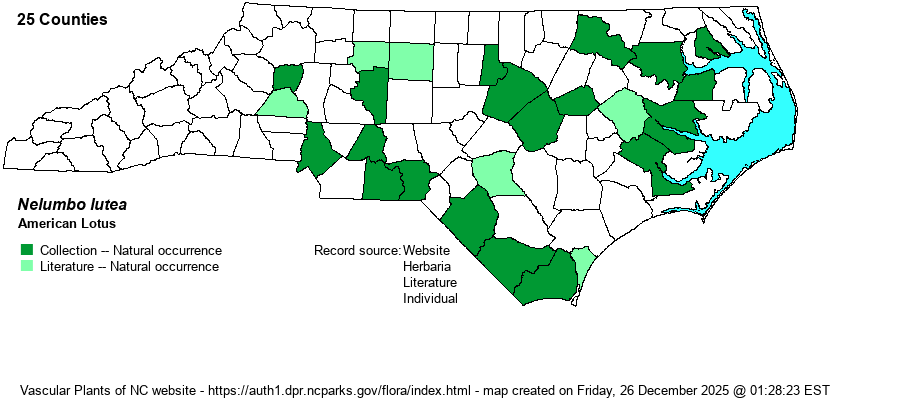| Author | Willdenow | |
| Distribution | Widely scattered over the Coastal Plain and most of the Piedmont, but recorded from only a quarter of over 80 in these two provinces. Absent from the Mountains. Many authors believe that this species was transported by Native Americans to new sites and habitats; therefore determining what the "original" distribution was in a given state is almost impossible.
This species has a wide Eastern range but most populations are in the Mississippi drainage and the Great Plains. It ranges east to NY and southern FL, but is essentially absent from the Appalachians and most of the Piedmont. | |
| Abundance | Rare to locally uncommon in the Coastal Plain and southeastern Piedmont, west to about Durham and Mecklenburg counties, and very rare west to Alexander County. This is a Watch List species. | |
| Habitat | This species was probably originally found in tidal freshwater marshes, where it can still locally be found. But it now is found at marshes around the margins of lakes and ponds, including reservoirs. It can also be found in the wider and calmer parts of some rivers, backwaters, and oxbows. Despite it having a wide array of freshwater habitats, and can occur in sizable monospecific colonies, it is a wonder and great surprise why it isn't common or at least found in many more places than it does occur. |
| Phenology | Blooms from June to September, and fruits in the latter part of summer or early fall. | |
| Identification | This is a very robust aquatic species, with most unusual flowers and leaves. It has numerous emergent leaves that can be held 1 foot or more above the water surface, with a rather flat and very large, orbicular leaf that is depressed in the center where the petiole attaches from below. This leaf average about 1.5 feet across! On separate stalks grow the flowers, held higher than the leaves, topped by a solitary flower. Each flower consists of several dozen light yellow petals and sepals (which are basically similar), spreading to about 10 inches across. After flowering, the receptacle in the center of each flower contains a few dozen acorn-sized seed; this receptacle is about 4 inches wide and across. Needless to say, when in leaf, in flower, or in fruit, it is so unlike any other native species that it cannot be mistaken. It can grow so densely that canoeists or other boaters can have difficulty navigating through a stand of it. When you do run across a stand of it, such as around the margins of Harris Lake in Wake County, you must scratch your head and wonder why all sizable lakes and reservoirs do not have colonies of this robust species. | |
| Taxonomic Comments | None
| |
| Other Common Name(s) | Yellow Lotus, Pond-nuts, Water Chinquapin | |
| State Rank | S2 [S2S3] | |
| Global Rank | G4 | |
| State Status | W7 [W1] | |
| US Status | | |
| USACE-agcp | OBL link |
| USACE-emp | OBL link |

